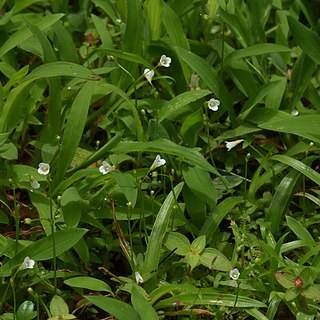Annuals or perennials, 5--20 cm tall. Stems terete, erect or creeping, simple, branched, or caespitose, basally densely white hirsute, apically glabrous or glabrescent; internodes shorter to longer than leaves. Leaves opposite, usually at least some and occasionally all in a dense whorl, subsessile; leaf blade ovate, oblong, or linear-lanceolate, 2--13 X 1--5 mm, herbaceous, abaxially hirsute on midvein, adaxially hirsute but glabrescent, rarely both surfaces ± glabrous, base broadly cuneate to attenuate, margin hirsute, apex obtuse to acuminate, lateral veins 3 inconspicuous pairs. Inflorescences terminal, sometimes also subterminal, long pedunculate, umbel-like, often irregularly compound, rarely reduced to a single long pedicellate flower; bracts ovate to ovate-lanceolate, ca. 3 mm, ciliate. Pedicel 5--9 mm. Calyx 1.5--2.8 mm; lobes narrowly triangular, as long as tube. Corolla white, pale yellow or rarely bluish white, campanulate, 3--8 mm, inside often sparsely bearded; lobes suborbicular, to 1.5 mm. Stamens included; filaments 1.5--3 mm; anthers narrowly ovate to sagittate, apex acute. Pistil to 4.5 mm. Ovary ca. 1 mm. Styles free for lower 1/4 to 1/3; stigma 2-cleft. Fruiting pedicel ca. 1.5 cm. Capsules subglobose, ca. 3 mm in diam., base enclosed by calyx, apex opening by loculicidal slits; style free or connate toward apex. Seeds ellipsoid to angular, minutely reticulate to papillate. Fl. May-Aug, fr. Aug-Dec.
Annual herb, erect, to 20 cm high. Stem scapose or scapiform; foliose part hispidulous or squamulose; bracteate part glabrous. Leaves elliptic, ovate or lanceolate, 3.5–15 mm long, 2–5.9 mm wide, hispidulous. Flowers in terminal and axillary compound umbellate clusters; pedicels to 32 mm long. Calyx campanulate, glabrous; tube 1–1.5 mm long; lobes 0.8–1.5 mm long. Corolla white; tube 2.5–7.5 mm long; lobes 0.5–1.5 mm long. Stamens 1.5–5.1 mm long; anthers obtuse or minutely apiculate; dehiscence extrorse. Capsule ellipsoidal, 2–3 mm long; fruiting style 0.5–5 mm long.

